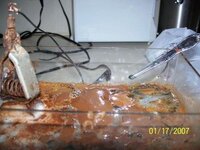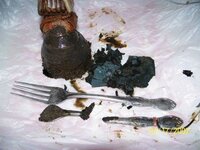Blind.In.Texas
Bronze Member
This fork is stainless steel. I left it in the tank over night. 15VDC@550mA. The whole fork is identical to the leftover fork below it. Let this be proof that metal can be destroyed by electrolysis. The following pictures are the result. The dome object is the one undergoing cleaning. I believe it to be made of brass. So far the brass is unharmed. This is mostly in part because of the corrosion on the object is, I believe, the path of least resistance. The corrosion can be easily scrubbed away this way. However, metal is subject to corrosion as well and this can eat your coppers. There are various other methods including using distilled water and baking soda. This will be less corrosive than the salt water approach. The damaging solution was 7 cups water andtwo teaspoons of iodized salt.
Copper coins, tokens, clad, and other copper items, especially disk shaped ones, will begin bubbling at the circumferance. Bwar in mind that the amount of catalyst added to your solution will determine just how much, if any, surface area is lost to the process. Get some copper pennies and experiment with different mixtures of saltwater. Also remember that the idea is to just pass current through the object causing a loosening of the crud.
I have heard it said to back the voltage off just until the bubbling stops. A potentiometer would be a good investment and they can be removed and re-used from old radios with a volume knob.
GL
Copper coins, tokens, clad, and other copper items, especially disk shaped ones, will begin bubbling at the circumferance. Bwar in mind that the amount of catalyst added to your solution will determine just how much, if any, surface area is lost to the process. Get some copper pennies and experiment with different mixtures of saltwater. Also remember that the idea is to just pass current through the object causing a loosening of the crud.
I have heard it said to back the voltage off just until the bubbling stops. A potentiometer would be a good investment and they can be removed and re-used from old radios with a volume knob.
GL




 is that IF the clip is submerged in the solution the result you got is the result I got also. But once I kept that clip dry, the heavy eating away of the steel object slowed down considerbly.
is that IF the clip is submerged in the solution the result you got is the result I got also. But once I kept that clip dry, the heavy eating away of the steel object slowed down considerbly.


